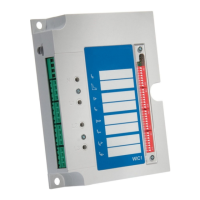
Do you have a question about the Seg WI Series and is the answer not in the manual?
SELF-/DUAL-POWERED PROTECTION DEVICE
Guidelines for correct installation, configuration, and safe operation of the WIC1.
Critical safety instructions and precautions for handling the WIC1 device.
Describes Smart view as parameter setting and evaluation software, requiring a PC and connecting cable.
Explains the intuitive operating concept with DiggiMEC and Smart view for commissioning.
Details the methods for supplying power to the WIC1, including permanent and temporary options.
Provides a functional overview of the WIC1, illustrating protection features and their integration.
Explains how to make settings for WIC1 variants using communication interface or DIP/HEX switches.
Details commands for resetting latched states and collective resets, including automatic and manual options.
Explains factory reset functionality, including parameter reset, password reset, and records deletion.
Shows main connector groups at the side of the WIC1, including Inputs, Outputs, PE, Ethernet, and RS485.
Details impulse output for trip coil, relay output for WIC1-4, and impulse output for flag indicator.
Instructions for proper grounding of the WIC1 housing, emphasizing low-inductance connections.
Dangers and guidelines for selecting WIC1-compatible current transformers, including voltage and conductor requirements.
Describes connecting PC to DiggiMEC for configuration, data retrieval, and saving settings via Smart view.
Serves as an outer frame for protection modules, defining Alarm vs. Trip behavior for each stage.
Provides a notice regarding potential issues with position indication methods and faulty switchgear positions.
Explains CT type selection, display options for measured values, and ground current transformer properties.
Details settings for Phase Overcurrent stages I>, I>>, I>>>, including characteristic, pickup, tripping delay, reset mode, and minimum trip delay.
Details settings for IG> and IG>> stages, including characteristic, pickup, tripping delay, reset mode, and minimum trip delay.
Details settings for I2> protection, including characteristic, pickup threshold, tripping delay, and reset modes.
Details SOTF settings: activating condition, trigger mode, activity duration, and tripping delay.
Explains the need for switchgear connection and correct configuration for fault clearing.
Covers Phase Overcurrent modules I>, I>>, and I>>>, detailing DEFT and Inverse-Time overcurrent protection functions.
Provides warnings and guidance on setting overcurrent parameters, considering device and CT limits.
Explains how inrush currents affect overcurrent functions and how the Inrush module prevents unwanted trips.
Details settings for the Inrush module: activation, threshold ratio, maximum current, blocking duration, and block mode.
Covers Earth Overcurrent modules IG> and IG>>, detailing DEFT and Inverse-Time protection functions.
Provides warnings and guidance for setting ground overcurrent protection, considering measured or calculated current.
Explains the I2/I1> protection function, similar to phase overcurrent but monitoring negative-sequence current I2.
Explains the I2> protection function, monitoring negative-sequence current I2, and its available characteristics.
Describes thermal overload protection, overload determination, warning levels, and reset conditions.
Details settings for Thermal Overload: base current, overload factor, time constants, pre-alarm level, and initial thermal level.
Explains Peak Overcurrent module for short detection times, used with SOTF, monitoring peak current values.
Details settings for Ipeak> protection: activation, supervision/tripping selection, pickup threshold, and tripping delay.
Describes SOTF module for instantaneous trip on faulty line energization, active after selectable conditions are met.
Explains the ExP module for tripping or alarming based on external signals via Digital Inputs.
Explains CBF module for backup protection when breaker fails, detecting failure via phase currents or position indicators.
Describes CBF module function: supervision timer started by trip signal, alarm issued if breaker not open.
Details the integrated backup phase overcurrent protection, activated automatically during device internal errors.
Explains TCM module for monitoring trip circuit readiness and issuing alarm signals upon interrupt detection.
Provides compressed information about faults, like trip causes, with pop-up window on DiggiMEC and PC analysis via Smart view.
Describes self-supervision checks during normal operation and startup for faulty operation detection.
Explains how to access self-supervision messages and assign events to DiggiMEC LEDs for immediate notification.
Lists error descriptions (SE1, SE2-5, SE18, SE19-23, SE24), their information, and corrective actions.
Details warning messages (SW1, SW2, SW3, SW4), their information, and corrective actions for power supply and configuration issues.
Covers troubleshooting for test winding short circuits, grounding issues, low-energy tripping coil failures, and binary output issues.
Addresses issues like no communication with Smart view despite connection, and ensures required TCP/IP ports are available.
Details setting the tripping delay for Phase Overcurrent Stage I>> using DIP/HEX switches.
Shows DIP/HEX switch settings for pickup current of Earth (Ground) Overcurrent Stage IG>.
Details DIP/HEX switch settings for the threshold Imax of the Inrush Blocking module.
